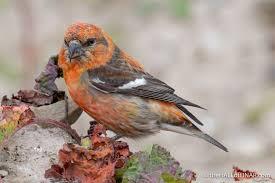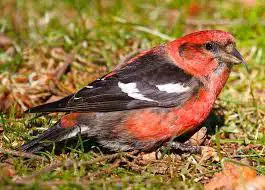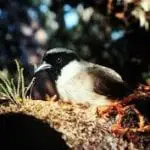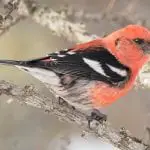Scientific facts
| Scientific name | Loxia leucoptera |
| Mass | 29 g (Adult) |
| Phylum | Chordata |
| Higher classification | Crossbill |
Description
Two-barred Crossbills are somewhat minor than Crossbills and have more slim beaks, which are still comparatively robust and crossed. Birds in all feathers have 2 extensive and characteristic white strips on each wing, expansion towards their vertebral column. Their tertial wing fluffs likewise have snowy tips. Males are mostly red in coloring, whereas females are bright yellowish-lime. Juveniles look like the young birds of other crossbill class and are mostly brownish-grey with marked plumage. Two-barred crossbills have chocolate legs, light brown beaks, and dark chocolate irises.
Appearance: The brightest and least crossbill originated in Finland. Beak lesser than that of further crossbills, and has 2 characteristic white stripes on wings. Male mostly bright pink in complexion, females yellowish-green, young fluff brownish with marked streaks.
Size: Length 14.5–16 cm, weight 25–34 g.
Nest: Tall up in coniferous vegetations near the crown, completed of moss and wreckages of decaying timber, lined on the external with dry spruce branches and bush lichen, and on the inside with dried sward, bush lichen, hairs, and fluffs.
Breeding: Places 3–5 eggs March–April, hatched by the female for 14–15 days. Novices leave layer within 22–24 days.
Distribution: Breeds crossways Finland, particularly in coniferous woods in eastern areas. Statistics vary importantly. Finnish breeding populace estimated to differ amid 1,000 and 20,000 pairs.
Migration: Irregular nomadic more usually found in areas further east, nonetheless, which may variety into Central Europe. Most normally travel August–October and February–March. Birds may season in Finland when nourishment is obtainable.
Diet: Seeds of neat, alder, cane and larch vegetations, spruce sprouts, and rowan berries.
Calls: Redpoll-like “psrit” beside a punitive “toot.” The song is comparable to that of Crossbill.
Habits and Lifestyle
Crossbills typically are found year-round in minor flocks. They characteristically hike about in established conifers; their bills life used to clutch cones and twigs. They also occasionally land on deciduous vegetations to fodder for aphids. With their bills modified for getting kernels out of cones, they start at the lowest and spiral uphill on a cone, snooping each gage open and taking out kernels with their tongues. Frequently, they will fodder in flocks. These daytime birds do not travel, but external the breeding period they variety widely penetrating for decent conifer kernel crops.
They familiarize well to the cold climate and seem to move as a reply to the obtainability of cone crops. Mass actions happen most frequently in fall, once the conifer cones mature. Such actions may include thousands of persons and may consequence in invasions by itinerant inhabitants of new areas. Red crossbills make dissimilar flight noises, each kind of sound spoken by birds of diverse bill form. Birds in a flock keep in interaction using a characteristic flight call, letting the separation of different clusters.
Mating Habits
Crossbills are exclusive, seeming to stay in couples throughout the year. Couples will form inside flocks. A male sings from a roost and makes exhibition flights entice a female. Throughout the breeding period, males are violent towards one another. Wooing includes the male nourishing the female and the couple clutching one another by the bill (named billing). The breeding series is related more carefully to food obtainability than to period, and the birds can breed nearly any period of the year, even in mid-winter, if the basis of seeds is plentiful.
One or two young are shaped per period, contingent on the variety. The female concepts the nest, on a high flat division in a conifer. 3 to 4 offspring are placed, light blue-green, and dotted with violet and chocolate. Development is by the female, for around 12 to 16 days, though the male fodders her by vomiting. The male feeds the altricial chicks for 5 days, then equally parents fodder the young. At around 18 to 22 days old, they leave the shell and are nourished by their parents for an additional month. They may turn out to be developed before they have their adult fluff, the moment 100 days old.
Fun facts
The bills of crossbills can cross either means; verbalizing the course, the bird will twist up the cone.
These birds’ brand lurid, tenacious, explosive “chip-chip” noises. A punitive “chewk” is produced when worried or happy, and the clear flight call they brand is “jip-jip-jip.”
The bill of a hatchling is not traversed when it hatches; nonetheless, it crosses as they mature. After 45 days, their bills are traversed sufficient for them to excerpt seeds themselves.
Flight noises of eight dissimilar types have been labeled for Red crossbills, besides birds that give each type have bills of somewhat dissimilar forms.
This type is so reliant on conifer kernels that they are even nourished to their young.
Crossbills are recognized together as a “crookedness” or a “twist” of crossbills.
Population threats
Crossbills presently are extensive and common in their varieties; nonetheless, these birds are contingent on established woods for food. Their inhabitants in most parts seem to be steady, nonetheless where deforestation is fast; there have been some failures.
Population number
Rendering to the IUCN Red List, the worldwide crossbill populace size is projected at 90-180 million established individuals. The breeding populace in Europe is 5,800,000-13,000,000 couples, associating to 17,400,000-39 million individuals. National populace approximations are: in China: 100-100,000 breeding couples, with 50-10,000 birds on relocation and scarcer than 1,000 individuals wintering; in Korea: 100-100,000 breeding couples, with 50-10,000 birds on relocation and scarcer than 1,000 wintering natures; in Japan: maybe 100-100,000 breeding couples, with 50-10,000 birds on relocation and less than 1,000 wintering birds; besides in Russia: 10,000-100,000 breeding couples plus 1,000-10,000 birds on relocation. General, presently, crossbills are classified as Least Concern (LC), and their statistics nowadays are stable.
Common Health Issues
Air Sac Mite Contagion in Birds
Birds agonize from lung and airway complaints, which can be produced by a diversity of respiratory vermin. One such scrounging infection in birds is produced by air sac mites, which marks the whole respiratory tract. The parasites can be current all the means from the nose of the ill bird to the miniature air sacs in the lungs.
The canaries and Gouldian finches are 2 kinds of birds that usually agonize from air sac mites.
Symptoms and Types
The indications of birds with air sac mites are reliant on the harshness of the parasitic contagion. Birds with a mild contagion might not have any symptoms at all. Those with a severe contagion, though, may display such indications as:
- Breathing difficulties (counting making screeching and clicking resonances)
- Exposed mouth breathing
- Bobbing of the end
- Extreme salivation
Microbial And Fungiform Skin Contagions in Birds
Avian Skin Contagions
Much like people, birds agonize from skin contagions. In birds, they can be because of wound or contagion and usually consequences in redness and bulge. And if the bird uninterruptedly pecks at the contagion, it might be ulcerate.
Indications and Types
In general, indications affecting the skin comprise:
- Itching
- Soreness
- Bulge
If your birdie is pecking a skin part more than normal, check for contagion and take the birdie to the veterinarian for good analysis and medicine.
There are numerous kinds of skin contagions in birds, counting:
Microbial skin infections – produced by bacteria, for example, bacilli, staphylococci, besides streptococci. Bumblefoot (pododermatitis) is produced by staphylococci.
Fungiform skin infections – produced by numerous fungi like ringworm, Cryptococcus fungi, malassezia yeast, etc. They can happen anywhere on the form. Equally, yeast infections occur typically around the beak.
Microbial Diseases in Birds
Birds are vulnerable to numerous types of microbial diseases — typically caused by a deficiency of cleanliness or stress — nonetheless, some birds have hereditary immunity and as an alternative become transporters of these illnesses, able to contaminate other birds.
Though, there are times transporter birds can turn out to be sick if they are confronted with infection activates like age (very undeveloped or old birds), ill health because of other contagions or diseases, ecological or expressive stress, or anything different that provisionally lowers a bird’s immunity to microorganisms.
Symptoms and Types
Indications for a bird will be contingent on the kind of bacteria, its site in the figure, and the organs it is distressing. Common indications in most microbial diseases comprise lethargy, weight loss, and damage of appetite.
More exactly, stomach contagions show digestive indications, for example, a lack of appetite, besides diarrhea. Liver contagions display peptic and urinary difficulties. Lung contagions can affect and chief to breathing problems, nasal emancipations, and eye contagious. Finally, the nervous system contagions will reason shakes and seizures in birds.
Microbial Contagion of Small Intestines in Birds
In birds, clostridial illness is a microbial contagion of the small intestines. Though, it can affect manifold body organs, contingent on the exact clostridial microorganisms involved.
Indications are reliant on the kind of clostridial microorganisms, but it can distress numerous organs in the bird’s figure. Usually, clostridial microorganisms poison the bird’s small intestines and produce poison. This poison is accountable for many of the indications, counting a rapid worsening of health, loss of hunger, weight loss, lethargy, bloody feces, or undigested nourishment.
Even afterward, the fowl is cured of bacterial contagion; the poison will endure in the bird’s body — producing the indications to linger.
Bird Flu in Birds
Avian influenza (or bird flu) is a lung besides airway illness found in birds; then, it is produced by the influenza disease. This viral contagion can likewise spread to people, so if your birdie is diseased, seek instant treatment, and take all needed defenses to stop an epidemic of bird flu.
Since of its communicable potential to people, any escape of avian influenza has to be stated to the Center for Disease Control and Prevention (CDC) in the United States. Lately, a prohibition has been located on introduced pet birds from republics where bird flu has been stated (i.e., certain African, Asian, besides European countries).
To make certain your new fowl does not consume avian influenza, get it inspected by a veterinarian for communicable diseases and ask about the bird’s roots.
Symptoms and Types
The indications for avian influenza comprise:
- Lack of hunger
- Breathing difficulties
- Bulge of the head
- Emancipation from the eyes
- Diarrhea
- Unhappiness
It is significant to note that not all natures diseased with avian influenza will show indications and that it can die abruptly. Furthermore, if not treated in a while, the casualty degree for bird flu is high.
Broken and Hurt Beak in Birds
How Birds Usage Their Beaks
A bird’s beak contains the bones of the higher (mandible) than lower (maxilla) jaws, which are enclosed by a coating of connective flesh (the dermis besides epidermis) and a firm, keratin protein outside cover. Several blood vessels besides nerves source the dissimilar parts of the beak; besides, parrots have an attentiveness of nerve endings close the tip of the beak, named the bill tip organ, that brands the beak very subtle to temperature and weight changes.
Birds’ beaks purpose like mammals’ lips then teeth; they grip and crush nourishment, and they differ in form and size from type to type. Beaks are likewise used to operate objects, aid in protection, explore environs, build nests, then groom.
Beaks Never Stop Mounting
Though the bones of the beak nurture only till the adult beak scope is grasped, the keratin protein unceasingly produces in parrots from the base of the beak, adjacent to the appearance, out in the direction of the tip at a degree of ¼ to ½ inch apiece month. Domesticated birds that usage their beaks to grip food, hike, and operate objects will overcome the tips and flanks of their beaks as they raise, removing the need for beak trimming. Wounds to the base of the beak, adjacent to the appearance, may constrain regrowth.
What Causes Beak Wounds?
Birds that usage their beaks to aid them to hike around their birdcages or that portion on birdcage bars or hard timber may infrequently chip off small smithereens of the keratin outer-covering on the tips and flanks of their beaks. This is usual and usually not a reason for fear, providing the chips to the beak are not too big, and on condition that the bird lasts to eat and act generally.
Severe beak wounds are usually the consequence of direct shock. They frequently suffer from beak holes, crushing wounds, lacerations, bone breaks, displacements/luxations, burns, besides avulsions (the beak is flaking from the face). These shocks can happen as a consequence of bouts from further animals (e.g., cage mates, additional household domesticated animal, wild faunae) and blunt power interaction (hitting ramparts, falling off roosts).
Less frequently, beaks will have an irregular arrival or shape because of congenital or hereditary flaws, malnutrition (most frequently from the absence of protein and/or vitamins A and D, all vital to beak creation and development), contagion (with diseases, microorganisms, fungus, or parasites), or cancerous developments. Some systemic illnesses, for example, liver disease, can reason beaks to overgrow.
How to Know an Irregular or Hurt Bird Beak
Some irregular beaks are not right, whereas others are tougher to know as irregular.
Congenital irregularities are usually clear and most often seen as either a malocclusion (misalignment) of the upper besides lower beak, thus that they don’t meet correctly when the mouth ends; a scissor beak, where moreover the upper or lower beak diverges sideways, consequently that the 2 slides past each other like scissor blades; or a mandibular prognathism, in which the tip of the higher beak breaks inside the inferior beak.
Dislocated beaks characteristically distress the top beak and consequence from an involuntary hyperextension of the joint connecting the maxillary bone to the cranium. Birds with maxillary disarticulations cannot close their mouths totally, have trouble eating, and are perceptibly painful. The upper beak appearances shifted mounting, and in around cases, the jaw bone might be broken.
Beaks that are soft, distorted, or have a fragmented or stained surface can be the consequence of malnutrition.
Diseased beaks might also appear fragmented, stained, pitted, fluted, or dry and peeling.
Availability and where to get one
You can be able to get in touch with your local avian vet for referrals when it comes to this kind of bird. There are also specialized shops that cater to such types of birds.

Care Sheet
Diet: Seeds vs. Pellets
Kernel diets are nutritionally insufficient for birds. Seed foods are high in fat besides low in the vitamins, minerals, then protein that birds want to stay fit. Whereas birds can live provisionally on kernel diets, in time, long-lasting malnutrition will distress their immune systems, and they will get ill.
Pelleted foods are exactly articulated to meet the nutritional requirements of your feathered friend. They cover the right stability of vitamins, minerals, protein, carbohydrates, besides, fats that your birdie requires for best health. There is a sum of dissimilar pellets obtainable at your local pet stock or veterinary hospital. It is finest to evade pellets that are radiantly colored and choose for the tablets that do not cover food coloring. Request your vet which kind of pellets is greatest for your feathered friend.
Table Foods
Some birds love to consume table nourishments as well as their pellets. It is satisfactory to feed most fit low-fat, low-salt substances to your feathered friend. Fruits besides vegetables high in vitamin A are chiefly significant for parrots. Foods that are poisonous to your birdie and must be evaded comprise chocolate, alcohol, caffeine, avocado, besides extremely salted diets. It is significant to wash fruits besides vegetables prudently before nourishing them to your bird. Whereas table foods can enhance interest and change at mealtime, they must not have more than 20 percent of your bird’s régime.
Water
Significantly, your bird has admission to clean liquid continuously. Water cups need to be washed every day with soap; just washing out dishes with liquid is not passable to remove occupied microorganisms. Do not usage tubes or water flasks, as they are hard to clean methodically. Do not place vitamins, extras, or juice in your bird’s liquid, as this inspires microbial growth.
Housing: Cages
In over-all, we commend providing your fowl with the main birdcage you can pay for and have space for. Powder-coated besides stainless steel birdcages is harmless for birds. Galvanized wire birdcages, which are covered with zinc, can brand your fowl sick. Request your veterinarian which birdcage builders he or she endorses.
Perches
Timber dowel roosts of unwavering diameter can make sore, worn spots on the lowest of your bird’s feet. Normal division or roosts of variable diameter are finest.
Keeping Your Bird’s Setting Unsoiled
It is significant for your bird’s fitness to keep his setting unsoiled. Water plates should be washed every day with soap besides hot water. The birdcage papers must be altered day-to-day, and the bottommost of the crate must be washed methodically with soap as wanted to eliminate all wreckage, rinsed carefully, then sterile. A convenient antiseptic is a 1:32 dilution of the bleach than water. Make certain to methodically rinse away all hints of antiseptic before you return your fowl to his birdcage.
FAQ Section
What must be in a birdcage?
Line the bottommost of the birdcage with broadsheet or paper cloths, and change the coating every other day. Put nourishment and water plates in the birdcage, along with with a birdbath and more than a few roosts. You must also provide your fowl with safe figurines such as mirrors, chimes, and standings.
Where must I put my birdcage?
Birds need as a minimum one side of their birdcage up against a partition, as it delivers them with a sense of safety. The ideal assignment is in an angle where they can take 2 walls. Moreover, you shouldn’t place your bird’s cage unswervingly in front of a gap, as outside issues such as canines, hawks, besides storms, will fright them.
What is the best blanket for birds?
As far as sheet resources, not ever use corn cob, walnut shells, cedar splinters, pine splinters, or kitty litter. Each of these is unsafe for birds for manifold details.



